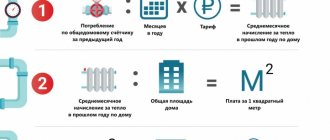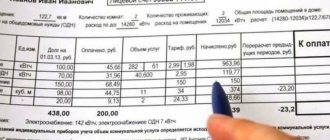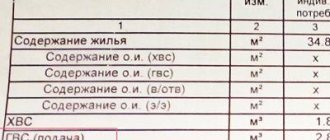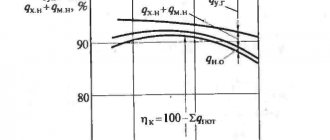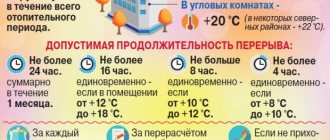In Ukraine, the unit of measurement of thermal energy is calculated in Gcal (gigacalories).
When the reporting month comes to an end, in order to transfer the heat meter readings to the heat supply organization, it is often necessary to convert the readings into gigacalories. Due to the fact that many do not know how to calculate correctly, we will give an example of how to do this: There are such quantities:
— Gcal (gigacalories Gcal), — GJ (gigajoules GJ), — MWh (megawatt hours MW*h), — KWh (kilowatt hours kW*h).
Conversion factor to gigacalories:
GJ (gigajoule) multiply by 0.2388 MW (megawatt) multiply by 0.8598 kWh (kilowatt) multiply by 0.8598 and divide by 1000 - get the value in Gcal.
Thermal energy has several measurement options.
Energy power, which is measured in Watts (W, mW and kW), is most often indicated on heating boilers, heaters, etc.
Another unit of energy measurement, the gigocalorie (Gcal), may be encountered when installing heat meters.
Also, the supplied heat is sometimes indicated in Gcal on payment receipts.
And if the calculation is accepted by the management company in one unit, and the meter shows another, it may be necessary to monthly convert Gcal to kW and back. Once you understand everything once, you can learn how to do it quickly and easily.
Subtleties of calculations: private house
The question of what Gcal is in heating and how it is calculated also arises among owners of private houses. However, heat calculations in the private sector have their own characteristics: owners can influence the price of one gigacalorie by choosing one or another heat source.
Gas boiler in a private house Source tehnoterm.kg
Each location has its own source of heat generation, with optimal prices for connection and operation. Most often, this energy resource is gas, and the coolant in the house is water, but other heat generators (or combinations thereof) are also possible, for example, coal, diesel, firewood or briquettes. Electrical energy is the most expensive resource.
A boiler for a home is purchased taking into account the optimal energy resource and power of the equipment itself. To find out whether the unit is suitable for a given house, calculate the smallest value of its power. To do this, the total area of the house (living and utility rooms) is divided by the specific power of the boiler.
After the boiler has been selected, it is necessary to calculate the heating system, that is, to calculate what parameters the equipment should have, not only the boiler, but also the pump, pipeline, radiators, shut-off and distribution valves. A correctly performed calculation will allow you to obtain a system that provides economical consumption of energy resources and high-quality heating of the house.
Elements of an electric heating circuit Source ytimg.com
There are several methods for calculating indicators. Since operating heating is a rather complex system, they all use corrections, constant values and coefficients in their calculations. It must be remembered that the calculations and selection of system components are influenced by the following loads, which have different origins:
- Permanent. Those that operate year-round. These include hot water supply, and in the northern regions - heating.
- Periodic. The load changes following seasonal changes in air temperature, which are superimposed on daily fluctuations (day and night).
- Convection thermal radiation. Dry heat produced by heating devices is measured with a dry bulb thermometer.
- Taking into account the load from evaporation and condensation. Processes proceed with heat transfer; Latent heat can be determined using a wet bulb thermometer.
What are calories
During the construction of buildings, all measurements and thermal calculations are made in gigacalories. Utilities also prefer this unit of measurement for its proximity to real life and the possibility of calculations on an industrial scale.
We remember from the school course that a calorie is the work needed to heat 1 gram of water per unit °C (at a certain atmospheric pressure).
- 1 Kcal = 1 thousand cal.
- 1 Gcal = 1 million Kcal, or 1 Billion. cal.
The following measurement can be used in heating receipts:
In the first case, we mean the supplied heat for a certain period (this could be a month, a year or a day). Gcal/hour is a characteristic of the power of a device or process (such a unit of measurement can indicate the performance of a heating device or the rate of heat loss of a building in winter). The receipts imply heat that was released in 1 hour. Then, to recalculate for a day, you need to multiply the number by 24, and for a month by another 30/31.
1 Gcal/hour = 40 m 3 of water, which was heated to 25 °C in 1 hour.
The simplest calculation methods
In the case when the system does not have a heat meter, an approximate calculation of Gcal for heating is used using a volume formula that looks like: Q=V(T1-T2)/1000. The following variable values are used:
- Q – consumed heat (consumption).
- V is the volume of hot water consumed, in a household measured in cubic meters.
- T1 – water leaving the boiler (or entering the system); if an average value is used, take 60-65°C.
Installation principle of heat meters Source meblor.ru
- T2 – cold water temperature (outlet). When the heating is on, use the indicator +5°C, in the summer +15°C.
- The coefficient of 1000 allows you to make the result clear (translation into gigacalories).
In a closed circuit, the thermal energy consumption Q (not to be confused with the water consumption) is calculated as follows: Q=V1(T1-T)-V2(T2-T). The decoding of the symbols is as follows:
- V1 is the flow rate of the working medium (water or steam) in the direct pipe, V2 is in the return pipe.
- T is the temperature of the cold environment. T1 – inlet temperature, T2 – outlet temperature.
For more accurate calculations of the heating system, you can use an online calculator. Such tools offer the ability to calculate heating radiators, heated floors, heat loss from a pipeline or room, as well as other elements of the system.
The heat meter is sealed like any energy metering system Source ecoteploiso.ru
How to convert energy units?
On the Internet you can actually find a huge number of online calculators that convert the required values automatically.
When it comes to figuring it all out, there are often lengthy formulas and proportions that can be off-putting to the average consumer who graduated from school many years ago.
But it’s possible to figure everything out! You will need to remember 1 or 2 numbers, an action, and you can easily make the translation offline, on your own.
Calculation of standard heat consumption
Dear Igor Viktorovich!
I asked your specialists for data on determining standards for heat consumption. The answer was received. But I also contacted MPEI, where they also provided a link to the calculations. I quote it:
Borisov Konstantin Borisovich.
Moscow Energy Institute (Technical University)
To calculate the standard heat consumption for heating, you must use the following document:
Resolution No. 306 “Rules for establishing and determining utility consumption standards; Table 7 - “The value of the standardized specific heat energy consumption for heating an apartment building or residential building”).
To determine payment for heating for a residential premises (apartment), you must use the following document:
Resolution No. 307 “Rules for the provision of utility services to citizens” (Appendix No. 2 – “Calculation of the amount of payment for utility services”, formula 1).
In principle, the calculation of the standard heat consumption for heating an apartment and determining the payment for heating is not difficult.
If you want, let's try to roughly (roughly) estimate the main numbers:
1) The maximum hourly heating heat load of your apartment is determined:
Qmax = Qsp*Sq = 74*74 = 5476 kcal/h
Where
Qsp = 74 kcal/h - standardized specific heat energy consumption for heating 1 sq.
m of apartment building.
The value of Qd is taken according to Table 1 for buildings built before 1999, with a height (number of floors) of 5-9 floors at an outside air temperature of Tnro = -32 C (for the city K).
Sq = 74 sq. m – the total area of the apartment premises.
2) Calculate the amount of thermal energy required to heat your apartment during the year:
Qsr = Qmax×[(Tv-Tsr.o)/(Tv-Tnro)]×No×24 = 5476×[(20-(-5.2))/(20-(-32))]×215* 24=13,693,369 kcal = 13.693 Gcal
Where
TV = 20 C – standard value of internal air temperature in residential premises (apartments) of the building;
Тср.о = -5.2 С - outside air temperature, average for the heating period (for city K);
No = 215 days - the duration of the heating period (for city K).
3) The standard for heating 1 square meter is calculated. meters:
Convert Gcal to kW/h
The opposite situation is when you need to convert Gcal to kW. You need to know how many kW contains 1 Gcal
1 Gcal = 1163 kW.
This means that one gigacalorie of heat will need to be consumed to produce 1163 kilowatts of energy.
Or vice versa: 1163 kW of energy will be required to produce one Gcal of heat.
To convert the number of gigocalories you know into kilowatts, you need to multiply the existing Gcal indicator by 1163.
It is necessary to convert 0.5 Gcal into kilowatts.
0.5 x 1163 = 581.5 kW.
Hydraulic calculation
So, the heat loss has been determined, the power of the heating unit has been selected, all that remains is to determine the volume of the required coolant, and, accordingly, the dimensions, as well as the materials of the pipes, radiators and shut-off valves used.
First of all, we determine the volume of water inside the heating system. This requires three indicators:
- Total power of the heating system.
- Temperature difference at the outlet and inlet of the heating boiler.
- Heat capacity of water. This figure is standard and equal to 4.19 kJ.
Hydraulic calculation of the heating system
The formula is as follows: divide the first indicator by the last two. By the way, this type of calculation can be used for any part of the heating system
Here it is important to divide the line into parts so that in each the speed of movement of the coolant is the same. Therefore, experts recommend making a breakdown from one shut-off valve to another, from one heating radiator to another
Now we move on to calculating coolant pressure losses, which depend on friction inside the pipe system. To do this, only two quantities are used, which are multiplied together in the formula. This is the length of the main section and specific friction losses.
But pressure losses in shut-off valves are calculated using a completely different formula. It takes into account indicators such as:
- Coolant density.
- Its speed in the system.
- The total indicator of all coefficients that are present in this element.
In order for all three indicators, which are derived by formulas, to fit standard values, it is necessary to select the correct pipe diameters. For comparison, we will give an example of several types of pipes to make it clear how their diameter affects the heat output.
- Metal-plastic pipe with a diameter of 16 mm. Its thermal power varies in the range of 2.8-4.5 kW. The difference in the indicator depends on the temperature of the coolant. But keep in mind that this is a range where the minimum and maximum values are set.
- The same pipe with a diameter of 32 mm. In this case, the power varies between 13-21 kW.
- Polypropylene pipe. Diameter 20 mm - power range 4-7 kW.
- The same pipe with a diameter of 32 mm - 10-18 kW.
And the last thing is the definition of a circulation pump. In order for the coolant to be evenly distributed throughout the heating system, it is necessary that its speed be no less than 0.25 m/sec and no more than 1.5 m/sec. In this case, the pressure should not be higher than 20 MPa. If the coolant velocity is higher than the maximum suggested value, the pipe system will operate noisily. If the speed is lower, airing of the circuit may occur.
Conversion table
A quick translation of round numbers can be done using tables:
| Gcal to kW | ||||||||
| gigacalories/hour | 1 | 2 | 3 | 4 | 5 | 10 | 15 | 20 |
| kW | 1163 | 2326 | 3489 | 4652 | 5815 | 11630 | 17445 | 23260 |
| kW to Gcal | |||||||
| kW | 1000 | 5000 | 10000 | 30000 | 50000 | 100000 | 500000 |
| gcal/h | 0.85984 | 4.29922 | 8.5984 | 25.795 | 42.992 | 85.984 | 429.9226 |
Calculation formula
Thermal energy consumption standards
Thermal loads are calculated taking into account the power of the heating unit and the heat losses of the building. Therefore, in order to determine the power of the designed boiler, it is necessary to multiply the heat loss of the building by an increasing factor of 1.2. This is a kind of reserve equal to 20%.
Why is such a coefficient necessary? With it you can:
- Predict the drop in gas pressure in the pipeline. After all, in winter there are more consumers, and everyone tries to take more fuel than others.
- Vary the temperature inside the house.
Let us add that heat losses cannot be distributed evenly throughout the entire building structure. The difference in indicators can be quite large. Here are some examples:
- Up to 40% of the heat leaves the building through the external walls.
- Through floors - up to 10%.
- The same applies to the roof.
- Through the ventilation system - up to 20%.
- Through doors and windows - 10%.
So, we sorted out the design of the building and made one very important conclusion: the heat losses that need to be compensated depend on the architecture of the house itself and its location. But much is also determined by the materials of the walls, roof and floor, as well as the presence or absence of thermal insulation
This is an important factor.
For example, let’s determine the coefficients that reduce heat loss, depending on window structures:
- Ordinary wooden windows with ordinary glass. To calculate thermal energy in this case, a coefficient of 1.27 is used. That is, through this type of glazing there is a leakage of thermal energy equal to 27% of the total.
- If plastic windows with double-glazed windows are installed, then a coefficient of 1.0 is used.
- If plastic windows are installed from a six-chamber profile and with a three-chamber double-glazed window, then a coefficient of 0.85 is taken.
Let's move on, dealing with the windows. There is a certain relationship between the area of the room and the area of window glazing. The larger the second position, the higher the heat loss of the building. And there is a certain relationship here:
- If the window area in relation to the floor area has only a 10% indicator, then a coefficient of 0.8 is used to calculate the thermal power of the heating system.
- If the ratio is in the range of 10-19%, then a coefficient of 0.9 is applied.
- At 20% - 1.0.
- At 30% -2.
- At 40% - 1.4.
- At 50% - 1.5.
And these are just the windows. And there is also the influence of the materials used in the construction of the house on thermal loads. Let's arrange them in the table, where wall materials will be located with a decrease in heat losses, which means their coefficient will also decrease:
Type of building material
As you can see, the difference from the materials used is significant. Therefore, even at the stage of designing a house, it is necessary to determine exactly what material it will be built from. Of course, many developers build a house based on the budget allocated for construction. But with such layouts it is worth reconsidering it. Experts assure that it is better to invest initially in order to later reap the benefits of savings from operating the house. Moreover, the heating system in winter is one of the main expense items.
Sizes of rooms and number of floors of the building
Heating system diagram
So, we continue to understand the coefficients that affect the heat calculation formula. How do room sizes affect thermal loads?
- If the ceiling height in your house does not exceed 2.5 meters, then the calculation takes into account a coefficient of 1.0.
- At a height of 3 m, 1.05 is already taken. It's a minor difference, but it has a significant impact on heat loss if the total area of the house is large enough.
- At 3.5 m - 1.1.
- At 4.5 m -2.
But such an indicator as the number of storeys of a building affects the heat loss of a room in different ways. Here it is necessary to take into account not only the number of floors, but also the location of the room, that is, on which floor it is located. For example, if this is a room on the first floor, and the house itself has three or four floors, then a coefficient of 0.82 is used for the calculation.
When moving a room to the upper floors, the rate of heat loss also increases. In addition, you will have to take into account the attic - whether it is insulated or not.
As you can see, in order to accurately calculate the heat loss of a building, it is necessary to determine various factors. And they all must be taken into account. By the way, we have not considered all factors that reduce or increase heat losses. But the calculation formula itself will mainly depend on the area of the heated house and on an indicator called the specific value of heat loss. By the way, in this formula it is standard and equal to 100 W/m². All other components of the formula are coefficients.
What are calories
During the construction of buildings, all measurements and thermal calculations are made in gigacalories. Utilities also prefer this unit of measurement for its proximity to real life and the possibility of calculations on an industrial scale.
We remember from the school course that a calorie is the work needed to heat 1 gram of water per unit °C (at a certain atmospheric pressure).
- 1 Kcal = 1 thousand cal.
- 1 Gcal = 1 million Kcal, or 1 Billion. cal.
The following measurement can be used in heating receipts:
In the first case, we mean the supplied heat for a certain period (this could be a month, a year or a day). Gcal/hour is a characteristic of the power of a device or process (such a unit of measurement can indicate the performance of a heating device or the rate of heat loss of a building in winter). The receipts imply heat that was released in 1 hour. Then, to recalculate for a day, you need to multiply the number by 24, and for a month by another 30/31.
1 Gcal/hour = 40 m3 of water, which was heated to 25 °C in 1 hour.
Also, a gigacalorie can be tied to the volume of fuel (solid or liquid) Gcal/m3. And it shows how much heat can be obtained from a cubic meter of this fuel.
Heat meters
Before calculating thermal energy in Gcal, you need to have practical information on hand. To calculate heating for a specific section of the system, the following data will be required:
- Temperature of the working medium (usually water) at the inlet and outlet.
Wiring a heat meter in an apartment Source wikimedia.org
- Water consumption (when passing through heating devices).
To measure temperature, various thermometers are used: from household and alcohol thermometers, to electric and infrared. It is convenient to determine the flow rate of the working medium using a meter; There are two types of heat metering devices.
Impeller counter
A mechanical meter (another name is tachometer) operates at temperatures from +5 to +150°C, and is also used for heating systems, for hot and cold water supply. The devices are divided into turbine and screw (according to the installation method). They react poorly to mechanical impurities, so the system must have a coarse filter. The impeller counter works according to the following principle:
- Water enters the meter, where there is an impeller with magnets installed on it.
- The impeller begins to rotate, and the number of revolutions is directly proportional to the amount of water flowing.
- The rotation is recorded by an accounting mechanism that is capable of processing incoming information and converting the number of revolutions into the volume of flowing water.
Mechanical heat meter Source pechiexpert.ru
Despite the simple design, meters with an impeller have proven themselves to be reliable devices with a fairly low response threshold. In addition, the units are equipped with an anti-magnetic screen, which prevents attempts by external influence on their operation
This is the ratio of Kal and Gcal to each other.
1 Cal 1 hectoCal= 100 Cal 1 kiloCal (kcal)= 1000 Cal 1 megaCal (Mcal)= 1000 kcal = 1000000 Cal 1 gigaCal (Gcal)= 1000 Mcal = 1000000 kcal = 1000000000 Cal
When they say or write on receipts, Gcal - we are talking about how much heat was supplied to you or will be supplied for the entire period - this could be a day, a month, a year, a heating season, etc. When they say or write Gcal/hour , this means how much heat they will release to you and me in one hour. If the calculation is for a month, then we multiply these ill-fated Gcal by the number of hours per day (24 if there were no interruptions in heat supply) and days per month (for example, 30), but also when we actually received heat.
Now how to calculate this same gigacalorie or hecocalorie (Gcal) allotted to you personally.
To do this we need to know:
- temperature at the supply (supply pipeline of the heating network) - average value per hour; - temperature on the return line (return pipeline of the heating network) - also average per hour. — coolant consumption in the heating system for the same period of time.
We calculate the temperature difference between what came into our house and what returned from us to the heating network.
For example: 70 degrees came, we returned 50 degrees, we have 20 degrees left. And we also need to know the water flow in the heating system. If you have a heat meter, look for the value in t/hour . By the way, using a good heat meter, you can immediately find Gcal/hour - or, as they sometimes say, instantaneous consumption, then you don’t need to count, just multiply it by hours and days and get heat in Gcal for the range you need.
True, this will also be approximately, as if the heat meter itself counts for each hour and stores it in its archive, where you can always look at them. On average, different heat meters store hourly archives for 45 days , and monthly archives for up to three years. Indications in Gcal can always be found and checked by the management company or service organization.
Summary of all calculations
Correctly performed calculation of thermal energy consumption is the key to economical expenditure of funds spent on heating. Giving an example of the average value, it can be noted that when heating a residential building with an area of 200 m² in accordance with the calculation formulas described above, the volume of heat will be approximately 3 Gcal per month. Thus, taking into account the fact that the standard heating season lasts six months, then over six months the consumption volume will be 18 Gcal.
Of course, all measures for calculating heat are much more convenient and easier to carry out in private buildings than in apartment buildings with a centralized heating system, where simple equipment cannot be used.
